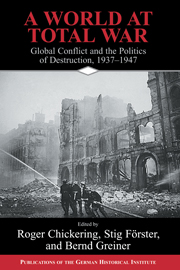Book contents
- Frontmatter
- Are We There Yet? World War II and the Theory of Total War
- Part A The Dimensions of War
- Part B Combat
- Part C Mobilizing Economies
- Part D Mobilizing Societies
- Part E The War against Noncombatants
- Part F Criminal war
- 17 Sexual Violence and Its Prosecution by Courts Martial of the Wehrmacht
- 18 Ideologies of Difference and the Turn to Atrocity: Japan’s War on China
- 19 On the Road to Total Retribution? The International Debate on the Punishment of War Crimes, 1872-194
- 20 Total War: Some Concluding Reflections
- Index
17 - Sexual Violence and Its Prosecution by Courts Martial of the Wehrmacht
Published online by Cambridge University Press: 05 January 2013
- Frontmatter
- Are We There Yet? World War II and the Theory of Total War
- Part A The Dimensions of War
- Part B Combat
- Part C Mobilizing Economies
- Part D Mobilizing Societies
- Part E The War against Noncombatants
- Part F Criminal war
- 17 Sexual Violence and Its Prosecution by Courts Martial of the Wehrmacht
- 18 Ideologies of Difference and the Turn to Atrocity: Japan’s War on China
- 19 On the Road to Total Retribution? The International Debate on the Punishment of War Crimes, 1872-194
- 20 Total War: Some Concluding Reflections
- Index
Summary
“Warfare with and against civilians is one of the hallmarks of total war,” writes Stig Förster. Despite continuing disagreements among historians over which wars can be characterized as “total,” there is consensus on the factors that define the concept. The primary markers seem to be the extent and intensity of warfare, the adoption of limitless war aims, the abolition of restraints posed by morality or law, and the systematic mobilization of all available economic, social, and political resources for the war effort. These features of total war entail the “calculated erasure of the bounds between combatant and noncombatant,” the transformation of civilians into principal victims of military violence. Although the losses during the global conflict from 1939 to 1945 cannot be calculated with any precision, civilian casualties far exceeded military losses. In the Soviet Union, two-thirds of all the losses were civilian.
Despite the importance of civilian casualties in total war, little research has been done on one of the problem's central aspects: gender-specific crimes, particularly sexual assaults on girls and women. Wartime rape has remained a taboo for historians. Susan Brownmiller's pioneering work on sexual crimes in wartime was first published in 1975, but her work has found few successors. It has taken the public outcry over the mass rapes of Bosnian women during the Yugoslavian civil war to renew scholarly interest in sexually related war crimes.
- Type
- Chapter
- Information
- A World at Total WarGlobal Conflict and the Politics of Destruction, 1937–1945, pp. 317 - 332Publisher: Cambridge University PressPrint publication year: 2004



